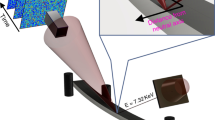Abstract
We discuss the universal features of the relaxation observed in glass formers near the structural-glass transformation temperature Tg. A macroscopic analysis of the relaxation dynamics is given using the correlation-length growth concept and the relevant diffusion exponent zg. Macroscopic relations, which expose temporal and spatial correlations, are proposed in terms of the characteristic temperatures, the exponent zg, and the fragility mg, related to the timescale. A stochastic approach to the problem at a mesoscopic level results in kinetic relations for zg, and the late-time and short-time asymptotic decay-law exponents; the Kohlrausch-Williams-Watts exponent βg and the von Schweidler exponent bg, respectively. A primary relaxation mechanism of anomalous diffusion, established for the amorphous polymers, leads to the kinetic equation zg=3(1/βg−1). Predictions for zg, based on the same mechanism, are given for the family of site-substituted orientational glasses. For the orientational glass in plastic crystals a distinct mechanism yields a new relation, zg=C(2−1/βg) with a constant C, deduced from dielectric loss data.
Similar content being viewed by others
REFERENCES
D. L. Leslie-Pelecky and N. O. Birge, Phys. Rev. Lett. 72, 1232 (1994); — Phys. Rev. B 18, 13 250 (1994).
U. T. Höchli, K. Knorr, and A. Loidl, Adv. Phys. 39, 405 (1990).
A. Loidl and R. Böhmer, in: Disorder Effects on Relaxational Processes: Glasses, Polymers, Proteins, ed. by R. Richert & A. Blumen (Springer-Verlag, Berlin 1994) p. 659.
R. Brand, P. Lukenheimer, U. Schneider, and A. Loidl, Phys. Rev. Lett. 82, 1951 (1999); — Phys. Rev. B 56, R5713 (1997).
N. S. Sullivan et al., Phys. Rev. B 17, 5016 (1978).
A. B. Harris and H. Meyer, Canad. J. Phys. 63, 3 (1985).
K. Binder and J. D. Reger, Adv. Phys. 41, 547 (1992).
C. Bostoen and K. H. Michel, Phys. Rev. B 43, 4415 (1991).
B. Tadić, R. Pirc, and R. Blinc, Phys. Rev. B 55, 816 (1997).
R. Pirc, B. Tadić, and R. Blinc, Physica A 185, 322 (1992); — Phys. Rev. B 36, 8607 (1987).
V. B. Kokshenev, Solid State Commun. 104, 1 (1994); — Phys. Rev. B 53, 2191 (1996).
V. B. Kokshenev, Solid State Commun. 55, 143 (1985); — Sov. J. Low Temp. Phys. 13, 195 (1987).
R. Blinc et al., Phys. Rev. B 52, 15 217 (1995).
K. Kim and N. S. Sullivan, J. Low Temp. Phys. 114, 173 (1999).
W. Götze and L. Sjögren, Rep. Prog. Phys. 55, 241 (1992).
R. Böhmer et al., J. Chem. Phys. 99, 4201 (1993).
J. C. Phillips, Rep. Prog. Phys. 59, 1133 (1996).
V. B. Kokshenev, Physica A 262, 88 (1999).
J. Souletie and D. Bertrand, J. Phys. I (Paris) 1, 1627 (1991).
I. A. Campbell et al., Phys. Rev. B 37, 3825 (1988).
V. B. Kokshenev, Phys. Rev. E 57, 1187 (1998).
M. B. Isichenko, Rev. Mod. Phys. 64, 961 (1992).
J. Colmenero, Physica A 201, 38 (1993); — Phys. Rev. Lett. 69, 478 (1992).
G. Zumofen, J. Klafter, and A. Blumen in: Disorder Effects on Relaxational Processes: Glasses, Polymers, Proteins, ed. by R. Richert & A. Blumen (Springer-Verlag, Berlin 1994) p. 251.
K. L. Ngai, in: Disorder Effects on Relaxational Processes: Glasses, Polymers, Proteins, ed. by R. Richert & A. Blumen (Springer-Verlag, Berlin 1994) p. 89.
J. P. Bouchaud and H. Orland, J. Stat. Phys. 61, 877 (1990); J. Vilain et al., J. Phys. C 16, 1553 (1983).
V. B. Kokshenev, J. Low Temp. Phys. 111, 489 (1998).
Author information
Authors and Affiliations
Rights and permissions
About this article
Cite this article
Kokshenev, V.B., Sullivan, N.S. Mechanisms of Primary Relaxation near Orientational-Glass and Structural-Glass Transitions. Journal of Low Temperature Physics 122, 224–413 (2001). https://doi.org/10.1023/A:1004817321469
Issue Date:
DOI: https://doi.org/10.1023/A:1004817321469




